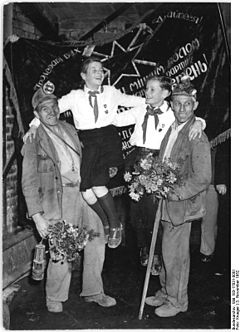- The Banner of Krivoy Rog
-
Die Fahne von Kriwoj Rog Directed by Kurt Maetzig Produced by Manfred Renger Written by Hans-Albert Pederzani (screenplay) Narrated by Helmut Schellhardt, Marga Legal Starring Erwin Geschonneck Music by Gerhard Rosenfeld Cinematography Erich Gusko Editing by Brigitte Krex Distributed by PROGRESS-Film Verleih Release date(s) 27 October 1967 Running time 108 minutes Country East Germany Language German The Banner of Krivoy Rog (German: Die Fahne von Kriwoj Rog) is an East German film, directed by Kurt Maetzig. It was released in 1967.
Contents
Plot
Otto Brosowski, a communist miner, writes to the miners in the Soviet city of Krivoy Rog, telling them of the harsh conditions in which he and his friends work, as the capitalist owners of the copper mine demand harder work. He receives a Red Banner from them. As the Nazis seize power, Otto and his family hide the flag from the authorities, taking great personal risks. At 1945, as the Second World War nears its end, the town is occupied by the Americans, who also wish to steel the Banner. At July 1945, as the Americans retreat and allow the Red Army to take over the area, the Brosowski family takes the flag and heads to meet the Soviets.
Cast
- Erwin Geschonneck: Otto Brosowski Senior
- Marga Legal: Minna Brosowski
- Helmut Schellhardt: Otto Brosowski Junior
- Harry Hindemith: Zonkel
- Fred-Artur Geppert: Rüdiger
- Eva-Maria Hagen: Elfriede
- Manfred Krug: Jule Hammer
- Jochen Thomas: Bode
- Kaspar Eichel: Walter
- Angela Brunner: Frau Bienert
- Willi Neuenhahn: Mellendorf
- Martin Flörchinger: driver
- Alfred Müller: Niedermeyer
- Rolf Ripperger: Bubi von Alvensleben
- Ilse Voigt: Mrs. Bode
- Dieter Wien: Peters
- Rudolf Ulrich: Bienert
- Horst Kube: Bartel
- Horst Giese: Gestapo spy
- Walter Kaufmann: Lieutenant Stone
- Harald Hauser: Colonel Wright
- Perry Friedman: American officer
- Horst Schäfer: American interpreter
- Fred Delmare: Communist driver
- Edwin Marian: Polish slave-laborer
- Erik Veldre: young worker
Production
The script of The Banner of Krivoy Rog was adapted from Otto Gotsche's popular novel by the same name, which was entered into the East German schools' curriculum. Gotsche's book was based on real events which took place in Gerbstedt before and during the Second World War: a man named Otto Brosowski had hidden a Red Banner he received from the miners in Krivoy Rog.[1] The Banner itself was kept as a symbol of Soviet-German friendship. Maetzig's film was commissioned for the 50th anniversary of the October Revolution.[2]
Reception
The film was viewed by 2,772,000 people in the two months from its release until the end of 1967, with 750,000 of them in the first two weeks; that figure also included those who saw it in mandatory screenings in collective farms and schools. It became the second most popular East German film of the year, after Chingachgook, the Great Snake.[3]
Maetzig, writer Hans-Albert Pederzani, actors Erwin Geschonneck and Marga Legal and cinematographer Erich Gusko were all awarded the National Prize, 1st degree, on 3 October 1968.[4] The film also won the Cinema Award of the magazine Junge Welt.[5]
Heiko R. Blum wrote that "the pathetic style, the hollow words... cannot destroy the picturesque quality of this impressive film, which is modeled after the classical Soviet epics."[2] The German Film Lexicon defined The Banner of Kriwoy Rog as "an fimpressive, historically insightful picture that conveys its propaganda in a humane manner."[6]
References
- ^ Stefan Zahlmann. Wie im Westen, nur anders: Medien in der DDR. Panama Verlag (2010). ISBN 978-3938714119. Page 176.
- ^ a b Heiko R. Blum. Film in der DDR. C. Hanser (1977). ISBN 978-3446124530. Page 67.
- ^ Thomas Beutelschmidt, Rüdiger Steinlein. Realitätskonstruktion: Faschismus und Antifaschismus in den Literaturverfilmungen des DDR-Fernsehens. Leipziger Universitätsverlag (2004). ISBN 978-3-937209-78-4. Page 96.
- ^ DEFA chronicle of 1968.
- ^ The Banner of Krivoy Rog. DEFA Stiftung.
- ^ The Banner of Krivoy Rog. 2001.de.
External links
- The Banner of Krivoy Rog at the Internet Movie Database
- The Banner of Krivoy Rog original poster on ostfilm.de.
- The Banner of Krivoy Rog on filmportal.de.
Films directed by Kurt Maetzig 1940s' Berlin under Construction (1946) · SPD-KPD Unity (1946) · Marriage in the Shadows (1947) · The Beaverskin (1949)1950s The Council of the Gods (1950) · The Benthin Family (1950) · Story of A Young Couple (1952) · Ernst Thälmann (1954-1955) · Castles and Cottages (1957) · Don't Forget My Little Traudel (1957) · The Sailor's Song (1958)1960s The Silent Star (1960) · September Love (1961) · Captain Loy's Dream (1961) · The Shadow (1961) · At A French Fireside (1963) · Preludio 11 (1963) · The Rabbit Is Me (1965) · The Girl on the Diving Board (1967) · The Banner of Krivoy Rog (1967) · Our Time (1969)1970s Janus Head (1970) · Man Against Man (1976)Cinema of Germany 
Film chronology · German Empire 1895–1918 · Weimar Germany 1919–1933 · Nazi Germany 1933–1945 · East Germany (1945–1990) ·
(West) Germany 1945–present · 1945-1959 · 1960s · 1970s · 1980s · 1990s · 2000s · 2010s
Actors · Directors · Films A–Z · Cinematographers · Festivals · Producers · Composers · ScreenwritersCategories:- 1967 films
- East German films
- German-language films
- Films directed by Kurt Maetzig
Wikimedia Foundation. 2010.

